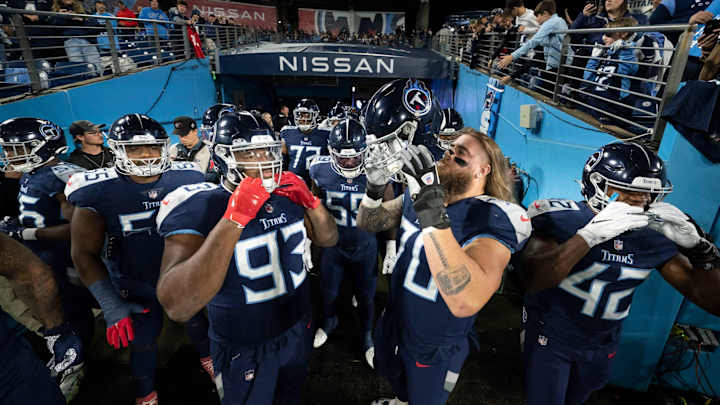Five Priorities for New GM Ran Carthon

In this story:
NASHVILLE – Having made multiple round-trip flights from San Francisco to Nashville in recent days, new Tennessee Titans general manager Ran Carthon may need a moment to catch his breath.
But the year-long NFL schedule waits for no one. So, Carthon, the former 49ers director of player personnel, will have to dive into his two-tone blue responsibilities quickly.
Here are five top priorities for the man who was officially announced as Jon Robinson’s replacement on Wednesday:
Developing a Big-Picture Outlook
In familiarizing himself with the Titans, Carthon’s first big decision will be which direction to take it. From 2016-21, the Titans posted six straight winning seasons, qualified for the playoffs four times and earned the AFC’s No. 1 seed in 2021. Then came 2022, when they crash-landed with seven straight losses and a 7-10 record. So, moving forward, does Carthon see the Titans more in the light of the six straight winning seasons or in last year’s losing campaign? In other words, does he believe the roster needs only minor repairs – and a return of healthy bodies – or is it in need of a massive makeover? There was no question which path the Titans needed to follow when Robinson took over as GM in 2016. Then, the team was coming off a combined five wins in two years and held the top pick in the draft. It’s not as clear cut this time around, as arguments could be made on both sides. Carthon’s decision here will shape the course of his first offseason.
Scrutinize the Scouting System
Every team has its own system and style of evaluating college prospects. For the past six years, Titans scouts have made their evaluations based on what Robinson thought was best. Like with all teams, there were hits and misses. The 2019 and 2022 draft crops, for instance, look strong, while the 2020 and 2021 classes have produced very little. It’s not yet crystal clear how much involvement Carthon had with the 49ers’ drafts over the last two years as the team’s director of player personnel. But in his stints over the past 15 years as a pro scout and director of player personnel, Carthon has no doubt come to prioritize certain skills and characteristics more than others. His beliefs will be transferred to Titans scouts as they prepare their list of prospects for the 2023 NFL Draft.
Who’s Staying and Who’s Going?
Carthon will face plenty of roster decisions – and plenty of deadlines – before the NFL free-agency period begins on March 15. More than 20 members of the current roster are not under contract for 2023, a group that includes unrestricted free agents like linebacker David Long, guard Nate Davis, tight ends Austin Hooper and Geoff Swaim, defensive linemen DeMarcus Walker, linebacker Dylan Cole and safety Andrew Adams as well as restricted free agents like guard Aaron Brewer, nose tackle Teair Tart and wide receiver Nick Westbrook-Ikhine.
But some of the decisions Carthon faces involve players who are under contract moving forward. For instance, will he seek to negotiate a long-term deal for defensive tackle Jeffery Simmons, as opposed to letting him play out his option year in 2023? And who will the Titans choose to cut in order to free up much-needed space under the salary cap? Some of the big names – and big salaries – he’ll scrutinize will include tackle Taylor Lewan, linebackers Bud Dupree and Zach Cunningham, quarterback Ryan Tannehill and wide receiver Robert Woods among others.
Free Agency and NFL Draft Priorities
Where do the Titans focus their offseason attention, given their cap space and draft capital? The offensive line clearly looks like one position group of need, considering how poorly the line played last season, how many players were injured and the question marks surrounding some starters. Wide receiver looks like it should be another target, after a season in which running back Dontrell Hilliard led the team in touchdown receptions (four). But what about the secondary, which, despite a number of recent high picks, finished last in the league in passing defense, allowing 275 yards per game? Carthon’s decisions here will shape the way the staff looks at college and pro prospects over the next several weeks. The Senior Bowl is Feb. 4, the NFL Combine runs Feb. 27-March 6 and draft itself is April 27-29. The negotiation period for NFL Free Agency begins March 13.
Setting Up His Hierarchy
Who will Carthon choose as his right-hand helpers, the people he turns to most often when making weighty decisions? Making those selections may sound like something a new GM does right away, but that’s often not the case. Most new general managers are named to their jobs around this time of year when a team’s scouting staff – and its personnel evaluators – already have spent months preparing for the draft and free agency. So, it’s common for new GMs to keep the current group in place through the draft before making front-office and scouting decisions for the future. An example: Robinson was named GM in January 2016, but didn’t hire Ryan Cowden, the Titans’ vice president of player personnel, until May of that same year – after the draft. That’s also when Robinson chose to part ways with some of the scouting staff from the previous regime. It will be interesting to see if Cowden remains with the organization after he was a finalist for Carthon’s job. In addition, Carthon will be on the lookout for someone to fill a role like that previously held by Monti Ossenfort, the former director of player personnel for the Titans, who is now Arizona’s general manager.
